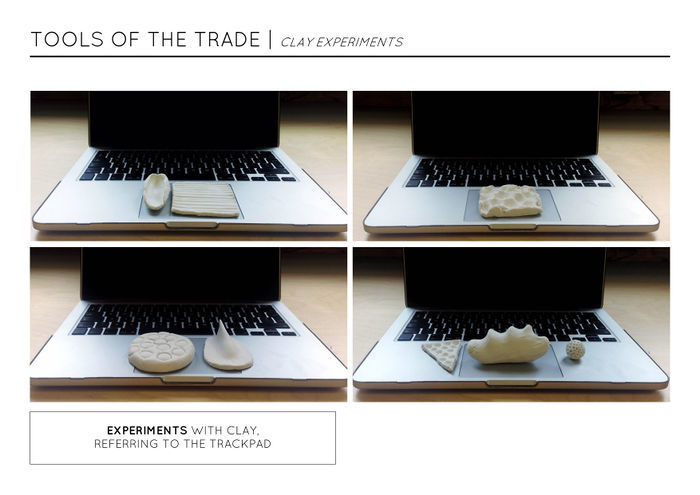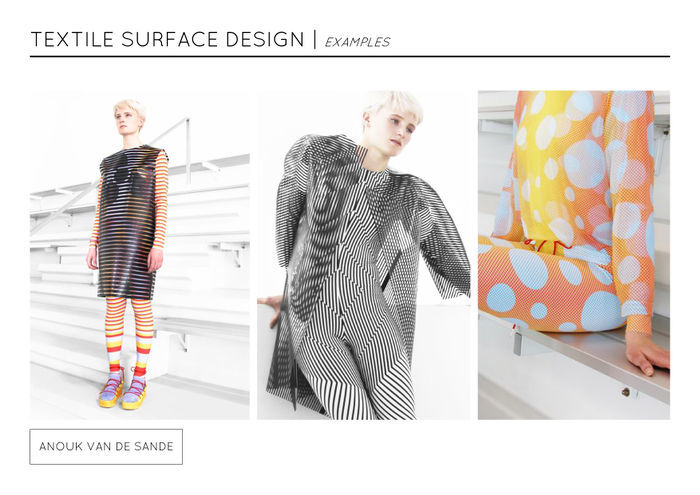Difference between revisions of "User:Dionne/Process Tools of the Trade"
| Line 33: | Line 33: | ||
All together this will give you a new textile experience. <br> | All together this will give you a new textile experience. <br> | ||
| − | [[File:TACTILITY-Tools-Of-The-Trade5.jpg | 700px]] | + | • '''Craft:''' Designing prints and patterns for textiles through the digital software Adobe Illustrator. <br> |
| + | • '''Problem:''' The physical experience between the user and the computer is very limited. There is not much interaction with the software | ||
| + | other then clicks and swipes on a trackpad, mouse or pen.<br> | ||
| + | • '''Tool(Kit)''': A tangible visualization of enhanced Illustrator tools that are physically exiting and triggers the sense to touch. | ||
| + | It creates a relation of the physical interface between humans and computers.<br> | ||
| + | • '''Goal:''' The tools exist out of ergonomic responsible shapes and materials, and are comfortable to work with. They respond on the | ||
| + | software Illustrator and create new possibilities and results in the field of Textile Print Design.<br> | ||
| + | • '''Software:''' The Illustrator tools are redefined and enhanced. The tools are responsive through capacitive touch and motion sensors. <br> | ||
| + | • '''Research:''' To the existence of the trackpad/mouse/tablet/pen etc. To understand why and how they are made the way they are today. <br> | ||
| + | • '''Statement:''' Write a good statement why this is useful for me and others and why this should change. | ||
| + | |||
| + | == '''INSPIRATION''' == | ||
| + | |||
| + | [[File:TACTILITY-Tools-Of-The-Trade5.jpg | 700px]] | ||
Graduated from the Design Academy Eindhoven with Print in Motion garments. <br> | Graduated from the Design Academy Eindhoven with Print in Motion garments. <br> | ||
They produce visual effects as the wearer moves. <br> | They produce visual effects as the wearer moves. <br> | ||
| Line 57: | Line 70: | ||
With her project she questioned 'Why couldn't man made objects offer, similarly stimulating experiences?'. <br> | With her project she questioned 'Why couldn't man made objects offer, similarly stimulating experiences?'. <br> | ||
She times to translate natures qualities into interior surfaces. <br> | She times to translate natures qualities into interior surfaces. <br> | ||
| − | |||
| − | |||
| − | |||
| − | |||
| − | |||
| − | |||
| − | |||
| − | |||
| − | |||
| − | |||
| − | |||
| − | |||
| − | |||
[[File:Tools of the Trade concept3.jpg | 700px]] | [[File:Tools of the Trade concept3.jpg | 700px]] | ||
Revision as of 13:48, 25 November 2015
THEME TACTILITY
• Sensory ability
• E-textiles
• stimulates the sense to touch
• makes the fabric come to life
• interact with the user*
• Playful three dimensional effect
• Tactile experience
* You can only fully experience the fabric by touching it
The theme that I am going to work with for the tools & trade project is: tactility.
In combination with the craft textile surface design.
The surfaces that I want to make have a sensory ability and are e-textiles.
They stimulate the sense to touch and it makes the fabric come to life.
It wil interact with the user, because you can only fully experience the fabric by touching it.
It will have a playful three dimensional effect which will give a tactile experience.
• An escape from your digitized everyday life*
• To reconnect with people in your surroundings
• To redefine your own identity
• Ability to change & adapt to our fast fashion industry
• Gives a new textile experience
*A respond to our contemporary society’s digitization
A few scenarios that exist while using these surfaces are the following:
It is an escape from your digitized everyday life and daily rituals.
This surface is a respond to our contemporary society’s digitization.
It will help you to reconnect with people in your surroundings, because you can experience it with as many people as you like.
It will redefine your own identity and show others where you stand for.
This surface has the ability to change & adapt to our fast fashion industry without having to throw it away immedieatly, this can be used for a longer period of time.
All together this will give you a new textile experience.
• Craft: Designing prints and patterns for textiles through the digital software Adobe Illustrator.
• Problem: The physical experience between the user and the computer is very limited. There is not much interaction with the software other then clicks and swipes on a trackpad, mouse or pen.
• Tool(Kit): A tangible visualization of enhanced Illustrator tools that are physically exiting and triggers the sense to touch. It creates a relation of the physical interface between humans and computers.
• Goal: The tools exist out of ergonomic responsible shapes and materials, and are comfortable to work with. They respond on the software Illustrator and create new possibilities and results in the field of Textile Print Design.
• Software: The Illustrator tools are redefined and enhanced. The tools are responsive through capacitive touch and motion sensors.
• Research: To the existence of the trackpad/mouse/tablet/pen etc. To understand why and how they are made the way they are today.
• Statement: Write a good statement why this is useful for me and others and why this should change.
INSPIRATION
Graduated from the Design Academy Eindhoven with Print in Motion garments.
They produce visual effects as the wearer moves.
This is called the moiré effect.
Although this is more about motion instead of touch, I like that her approach make the prints come to life.
Is an augmented modeling tool that lets you design 3d printed wearables directly on your body.
It uses depth sensing and projection mapping to detect and display touch gestures on the skin.
Every design is ready to be 3d printed and worn back on the body.
This project makes 3d printing accessible for the user and stimulates your touch senses.
Designed 'Tactile Dialogues' which is a textile object in the form of a pillow with integrated vibration elements that react on touch.
Their goal is to trigger physical communication patterns between a person with severe dementia and a family member.
What I like about this project is that it let the user reconnect with people they're surrounded with.
As a result of the dominance of visual and digital information in design, the surface qualities of our
immediate surroundings are often disregarded.
She says 'We live in a polished environment with little focus on haptic experiences'.
The diversity of tactile stimuli in nature is significantly larger than in our artificial surroundings.
With her project she questioned 'Why couldn't man made objects offer, similarly stimulating experiences?'.
She times to translate natures qualities into interior surfaces.
Marie Rouillon: Questions how can material experiences reconnect people with tactility in our digitised lives? The interactions that we
entertain with everyday devices are lacking sensibility, tactility and sensory experiences. As a textile designer, Rouillon is
particularly interested in what we call the sense(s) of touch. Daily Haptics has emerged as a response to this insight, through her
design, she is creating tactile experiences in order to reconnect people with tactility. Comprised of cups that look the same but feel
different, this series responds to contemporary society’s digitization and aims to re-engage people with tactile, material experiences.
Visual information alone is not enough, one needs to touch it to get full information. ‘I took the decision to communicate my
concept through everyday objects, without digital tools, in order to stress even more this urge to touch and experience the
everyday world we live in, through multi-sensory experiences.’
Royal College of Art graduate Ming Kong has created an elastic conductive material that can be moulded into different shapes, and to
create a haptic interface for manipulating digital models and files. Kong was frustrated with designing interfaces for electronics
products using only flat buttons, so decided to create three-dimensional tools for navigating digital environments. To do this, he
developed a conductive silicon-based material that can sense touch and directional movement across its surface, without sensors or
wires embedded within. Kong picked the best shapes in terms of ergonomics and in terms of electrical sensitivity.
RESEARCH
User:Dionne Research Tools of the Trade
MATERIAL EXPERIMENTS
CLAY
For the first experiments I took clay as a material to see which kind of shapes and forms I can make with my hand. With the Illustrator tools in mind I created a visualization. Although the outcome is very tangible, it is very stiff and has a hard surface. This will restrict the playful effect and fully experience the function of each tool. So clay is not the best material to work with, it gets hard and then it will break. I need a material that is flexible and elastic, which you can stretch out of proportion but when letting go of it, it'll return to it's original shape. Maybe silicone will work better.

